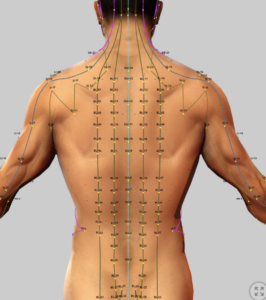Acupuncture:
Protracted Opioid Abstinence Syndrome (POAS)
Protracted opioid abstinence syndrome (POAS) involves persistent physical (e.g., pain, sleep disturbances) and psychological symptoms (e.g., anxiety, depression, opioid cravings) post-detoxification in opioid-dependent individuals, contributing to diificulty in tapering off opioid for pain and high relapse rates in opioid use disorder.
- See:
Acupuncture for Pain:
- Acupuncture – Fibromyalgia
- Acupuncture – Migraine
- Acupuncture – Osteoarthritis
- Acupuncture – Peripheral Neuropathy:
- Myofascial Pain:
- Acupuncture – Sciatica
- Acupuncture – Transition from Acute to Chronic Pain

Key to Links:
- Grey text – handout
- Red text – another page on this website
- Blue text – Journal publication
Definitions and Terms Related to Pain
Acupuncture for Protracted Opioid Abstinence Syndrome (POAS)
Prolonged opioid withdrawal symptoms sometimes persist for an excessively long time, making it difficult for patients who have been on long-term opioid pain management to taper off their opioids. This condition, Protracted Opioid Abstinence Syndrome (POAS), is also associated with individuals trying to discontinue their abuse of opioids in addiction (opioid use disorder – OUD). It should be pointed out that POAS distinctive from acute opioid withdraws syndrome, a state associated with acute detoxification from opioid use that generally resolves in days or weeks compared to POAS symptoms, which may prolong for weeks to months.
The withdrawal symptoms associated with POAS) include persistent physical (e.g., pain, sleep disturbances) and psychological symptoms (e.g., anxiety, depression, opioid cravings). Traditional opioid therapies (methadone, buprenorphine/Ssuboxone) for POAS often cause side effects like insomnia and cravings when tapered.
Alternative treatments such as acupuncture and related therapies (manual acupuncture [MA], electroacupuncture [EA], auricular acupressure [AA], transcutaneous electrical acupoint stimulation [TEAS], warm moxibustion) have been explored since the 1970s for their potential to manage withdrawal symptoms with minimal side effects. This treatise reviews the efficacy of acupuncture-related therapies specifically for POAS, focusing on protracted withdrawal symptoms rather than acute opioid detoxification.
A recently published systematic review and meta-analysis (Ding L, Li C, Zhang P, et al.) reviewed acupuncture and related therapies for POAS and is summarized here.
Acupuncture-related therapies for protracted opioid abstinence syndrome
- Study Characteristics: Included 28 random controlled trials (RCT with 2,463 POAS patients.
- First review focusing on POAS, with stringent inclusion/exclusion criteria that covered diverse acupuncture modalities, informing clinical practice, reflecting improved study quality compared to prior reviews
- Efficacy:
- Acupuncture vs. Sham Acupuncture: Significant reduction in withdrawal symptom scores (5 studies.
- Acupuncture vs. Western Medicine: Superior improvement in withdrawal symptoms (7 studies.
- Acupuncture vs. No Treatment: Significant improvement in withdrawal symptoms (3 studies.
- Secondary Outcomes: Improved anxiety, depression, sleep disorders, and somatic symptoms compared to controls; insufficient evidence for reducing opioid cravings.
- Acupuncture Modalities and Protocols:
- Modalities: manual acupuncture (MA), eletroacupuncure (EA), transcutaneous electrical acupoint stimulation (TEAS) ,auricular acupressure (AA), and warm moxibustion therapy. Treatment duration: 20–30 days; MA sessions ~2 weeks (20–30 min, 3–5 times/week); AA typically daily.
- Common acupoints: PC6 (Neiguan), HT7 (Shenmen), ST36 (Zusanli), SP6 (Sanyinjiao), reflecting “up and down matching points.”
- Mechanisms: Acupuncture stimulates acupoints (e.g., PC6, ST36), releasing Substance P and modulating opioid receptors, dopamine, and serotonin pathways, enhancing humoral-immune functions.
- Heterogeneity: High due to variations in acupuncture techniques, acupoint selection, and patient populations (mostly Chinese, suggesting regional bias).
Summary
Acupuncture-related therapies are potentially safe and effective for alleviating POAS withdrawal symptoms (anxiety, depression, sleep, somatic symptoms). However, these modalities lack definitive evidence for reducing opioid cravings, a key relapse driver in OUD.
Study Limitations:
- High risk of bias (only 11% low risk), especially due to blinding challenges in manual acupuncture.
- Regional bias (mostly Chinese studies).
- No subgroup analyses by modality or acupoint due to limited studies.
- Limited focus on long-term outcomes (e.g., cravings, relapse rates).
Conclusions:
Acupuncture treatment for 2+ weeks of MA/EA may reduce POAS symptoms, potentially as an adjunct to taping opioid doses. Acupuncture-related therapies show promise for alleviating POAS withdrawal symptoms, particularly anxiety, depression, sleep, and somatic issues, but evidence is limited by study bias, regional skew, and heterogeneity. Insufficient impact on cravings highlights a gap in relapse prevention.
Acupuncture treatment aligns with mechanisms like NMDA receptor modulation (e.g., synergy with magnesium citrate/bisglycinate, 400–600 mg/day). Future TCM herbal integration (e.g., Corydalis yanhusuo) could also enhance outcomes.
References:
- Ding L, Li C, Zhang P, et al. Acupuncture-related therapies for protracted opioid abstinence syndrome: a systematic review and meta-analysis. Evid Based Complement Alternat Med. 2018;2018:3724708. doi:10.1155/2018/3724708
Emphasis on Education
Accurate Clinic promotes patient education as the foundation of it’s medical care. In Dr. Ehlenberger’s integrative approach to patient care, including conventional and complementary and alternative medical (CAM) treatments, he may encourage or provide advice about the use of supplements. However, the specifics of choice of supplement, dosing and duration of treatment should be individualized through discussion with Dr. Ehlenberger. The following information and reference articles are presented to provide the reader with some of the latest research to facilitate evidence-based, informed decisions regarding the use of conventional as well as CAM treatments.
For medical-legal reasons, access to these links is limited to patients enrolled in an Accurate Clinic medical program.
Should you wish more information regarding any of the subjects listed – or not listed – here, please contact Dr. Ehlenberger. He has literally thousands of published articles to share on hundreds of topics associated with pain management, weight loss, nutrition, addiction recovery and emergency medicine. It would take years for you to read them, as it did him.
For more information, please contact Accurate Clinic.
Supplements recommended by Dr. Ehlenberger may be purchased commercially online
Please read about our statement regarding the sale of products recommended by Dr. Ehlenberger.
.
